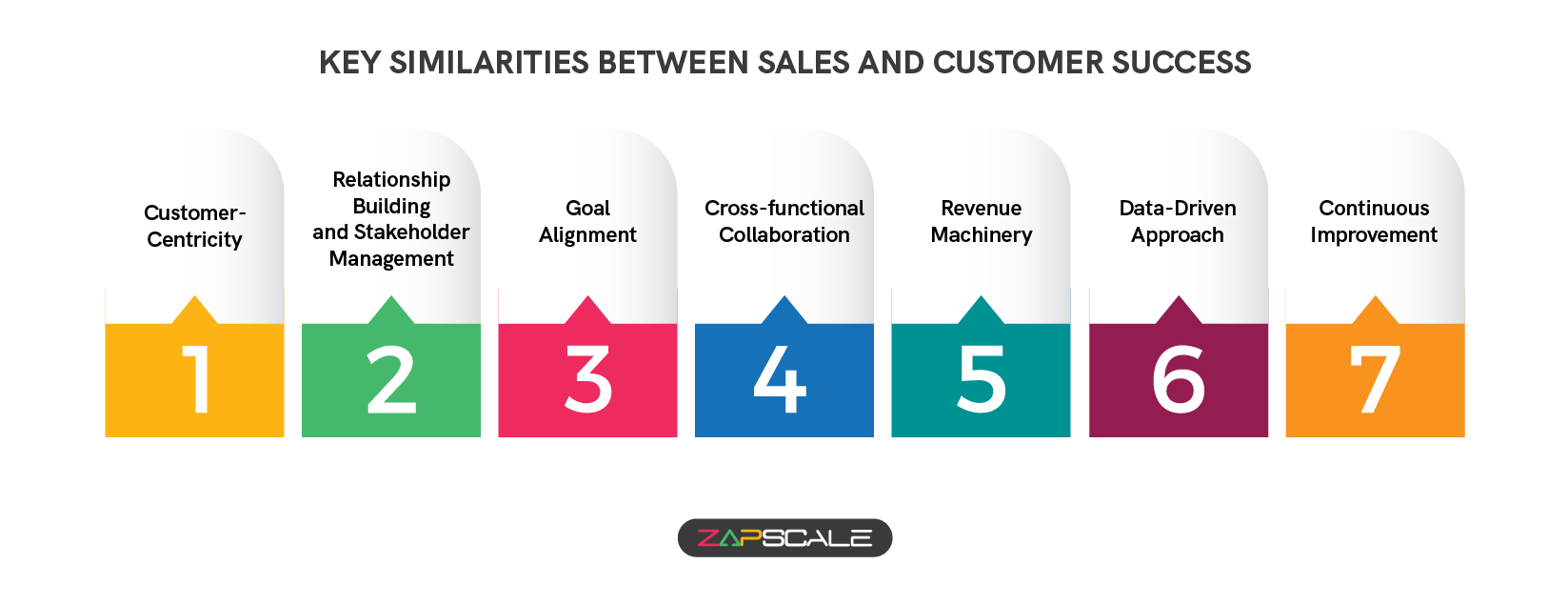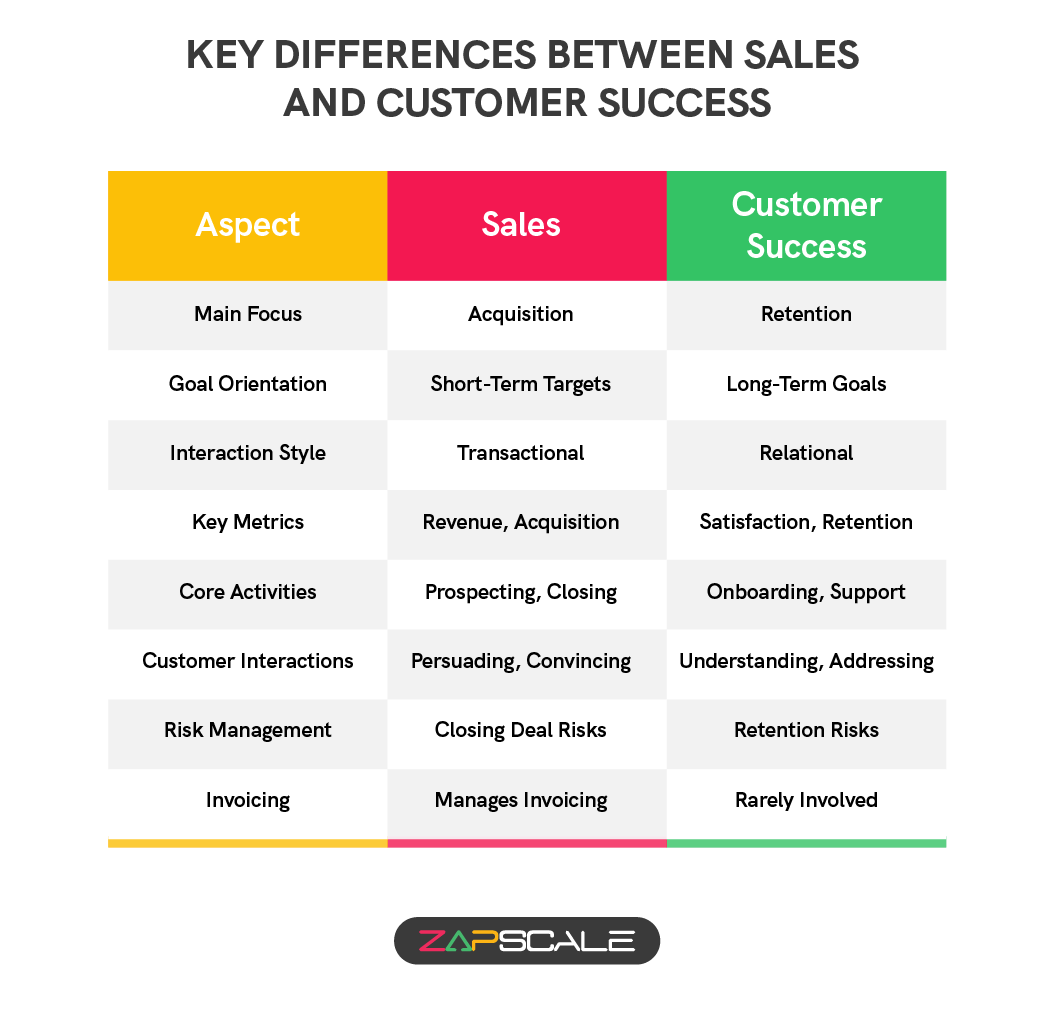CATEGORY > Customer Success Management
Key Differences and Similarities between Sales and Customer Success

I have never enjoyed writing about anything more than this topic.
Every CSM in an Indian SaaS setup has, at some point, been under this existential crisis whether he/she is largely a Sales/BD personnel or a Customer Success personnel which is largely put under Operations in some organizations, although it should be treated as an independent vertical.
I have been in that spot and there’s no shame in hiding that.
Every MBA campus has a Thalaiva professor, the marketing ones just go a notch higher in their popularity.
When they show you a Fevicol ad and talk about Piyush Pandey, you feel like after MBA (marketing folks) will be like sitting with a brand team and asking Hrithik Roshan to take a sip of Mountain Dew correctly.
Reality hits hard when you realise that, to probably someday make Hrithik drink your organisation’s beverage under your direction, you will have to sell the same beverage in remote villages of India for years, where you would be selling it to a “tapri” in 42 degrees, wearing formals and having a shining MBA degree from a top B-School, pitching hard why the villagers who just want a “thanda” (any cold beverage) should choose your drink over others.
Reality hits harder when you realise that after a given point in time, vertically upward on the corporate ladder, everything is revenue driven and totally commercial in nature.
The moment you befriend sales, life becomes easier.
During my MBA days, I was doing a mandatory internship with a leading FMCG brand in India. This brand is known to all and we have all used it at some point. I was their brand management intern.
During my tenure, a sales leader retired and in his farewell note, he simply addressed him as a “Salesman Forever”. This was in many ways, an ice breaker for me, ice-breaking with this feared term called “Sales”.
Why is sales scary?
Why is driving scary for many in Old Delhi or Banaras?
Because you do not know when a random bike or auto will come and scratch your brand-new car out of nowhere.
This means we are dealing with uncertainty with a lot of forces acting against us.
In a competitive market, every salesperson is attacked by client uncertainties, economic uncertainties, product performance issues, competitor strategies, etc. During Covid when the world was in lockdown and shocked to the core, no organisation in the world toned down their sales targets. That's why sales are scary. But all the courageous people who believe in “Dar ke aage jeet hai” start enjoying these challenges.
It becomes a passion for them to chase and overachieve targets. And why I gave this build-up on sales, you have to read till the end for that.
But why is it so closely related to customer success? Why can we not segregate them? Even if we do, then why the hullabaloo about it?
A customer is successful with your product only when the customer keeps using your product. Sales can ensure the first buy, repeated buying is a large game and CS plays a leading role in it.
Yet, CS and Sales are not the same things, and assigning the same KPIs to both of these would be suicidal, a dangerous catastrophe, something as dangerous as Chernobyl.
What Are The Similarities Between Sales And Customer Success?

1. Customer-Centricity
Both sales and customer success revolve around understanding and meeting customers' needs. While sales focus on acquiring new customers, customer success concentrates on retaining and nurturing existing ones.
In both cases, success depends on understanding customer pain points and offering tailored solutions.
2. Relationship Building and Stakeholder Management:
Both roles require building strong relationships with customers. Sales professionals establish trust and strong rapport during the sales process, while customer success managers maintain and strengthen these relationships post-sale. Both aim to foster long-term partnerships with customers.
CSMs will ensure strategic stakeholder management. They will work on building an ally-foe matrix and will climb up the stakeholder ladder as per strategic needs.
3. Goal Alignment
Based on that delivery, the customer decides to upgrade (upsell) or explore multiple other supplementary options (cross-sell).
Sales has newer territories to conquer, CS needs to water the fruiting plants already planted by sales (stakeholder management and customer engagement). Sales and customer success teams often have shared goals, such as customer satisfaction, retention, and revenue growth. While sales teams focus on acquiring new customers and closing deals, customer success teams work to ensure that those customers remain satisfied and continue to derive value from the product or service.
4. Cross-functional Collaboration
Collaboration between sales and customer success is game-changing for ensuring a seamless customer experience. Sales teams provide insights into customer needs and preferences gathered during the sales process, while customer success teams leverage this information to deliver ongoing support and value.
For commercial engagements during upsell, cross-sell, etc., CS will have to tag-team with Sales to drive the invoices and closing deals. Invoicing largely remains with Sales and Renewals with CS, both need to work hand in hand.
5. Revenue Machinery
Sales is often the pilot in revenue influx, CS ensures the influx goes on (renewals and retentions). While sales directly contribute to revenue generation through new customer acquisitions, customer success indirectly impacts revenue by driving customer retention and expansion. Satisfied customers are more likely to renew their subscriptions, purchase additional products or services, and act as brand advocates, ultimately leading to revenue growth.
6. Data-Driven Approach
Both sales and customer success rely on data analysis to inform their strategies and decisions. Sales teams use data to identify potential leads, track sales performance, and optimise their sales processes. Similarly, customer success teams analyse customer data to identify usage patterns, anticipate needs, and proactively address issues to ensure customer satisfaction and retention.
7. Continuous Improvement
Sales professionals continuously refine their sales techniques, adapt to market changes, and learn from both successful and unsuccessful sales interactions. Similarly, customer success teams continually seek feedback from customers, identify areas for improvement, and refine their approach to delivering value and support.
As CSMs work on CSAT, NPS, and Sales to work on feedback and processes to improve their approach.
By acknowledging these similarities, organisations can nurture collaboration between sales and customer success teams, ultimately driving better outcomes for both the company and its customers.
What Are The Dissimilarities?

1. Focus on Acquisition vs. Retention
The primary focus of sales is to acquire new customers and close deals, whereas customer success focuses on retaining and nurturing existing customers to ensure their satisfaction and long-term loyalty.
2. Short-Term vs. Long-Term Targets/Goals
Sales often operate on short-term goals, such as meeting quarterly revenue targets or closing a specific number of deals within a set timeframe.
In contrast, customer success typically has longer-term goals focused on ensuring customer satisfaction, retention, and lifetime value. Sales have strict revenue targets. CS has its revenue targets but the chief task of CS is not just ensuring higher revenue but many other strategic aspects. Sales is strictly a revenue influx function which maintains its due aggression in terms of customer acquisition.
Compared to this, CS is a more passive revenue function.
3. Transactional vs. Relational Approach
Sales transactions are often seen as one-off interactions focused on closing a deal, whereas customer success takes a more relational approach, aiming to build ongoing partnerships with customers and provide continuous value throughout the customer lifecycle.
4. Metrics and Key Performance Indicators (KPIs)
Sales teams typically measure success based on metrics such as revenue generated, new customer acquisition, and sales quotas achieved. Customer success, on the other hand, measures success based on metrics like customer satisfaction scores, retention rates, upsell/cross-sell revenue, and customer lifetime value.
5. Responsibilities and Activities
Sales responsibilities include prospecting, pitching, negotiating, and closing deals, often involving high-touch interactions with potential customers. Customer success responsibilities include onboarding, training, providing ongoing support, and ensuring customer satisfaction through proactive engagement and problem-solving.
6. Customer Interactions
Sales interactions are often focused on persuading and convincing prospects to make a purchase, while customer success interactions are focused on understanding and addressing the needs and challenges of existing customers to ensure their success and satisfaction.
7. Risk Management
Sales teams focus on identifying and mitigating risks related to closing deals, such as pricing negotiations or overcoming objections. Customer success teams focus on managing and mitigating risks related to customer satisfaction and retention, such as preventing churn or addressing product adoption issues.

8. Invoicing
Sales strictly manage invoices and work with Finance teams at the customer end to ensure invoicing is done correctly. CS rarely gets into invoicing, extremely rare to be honest.
Conclusion
While both sales and customer success are critical functions within an organisation, understanding these dissimilarities helps ensure that each team can effectively execute its unique responsibilities while working collaboratively to achieve shared goals.
CS cannot be burdened with JUST increasing revenue through upsells and cross-sells. Sales cannot be burdened to sell through wrong expectation settings.
Harmony and Synergy are the keys.
As CSMs, embrace the selling acumen and that’s why the buildup on sales earlier. This only adds another feather to your cap because, at super senior levels, it is all sales above everything else.
ABOUT THE AUTHOR

Ankit Acharya
Ankit is a seasoned Customer Success and Project Management professional with 8+ years of experience in IT, SaaS, and Product Organisations, having worked with Fortune 500 companies too. He is presently designated as a Sr Manager - Customer Success and Strategic Projects, working with a SaaS organization, building anti-counterfeiting products for consumer industries.
Popular from Customer Success Management
Quality Content,
Straight To Your Inbox!
Subscribe for the latest blogs, podcasts, webinars, and events!

Write a Blog
If you have experience in CS and
a flair for writing, we’d love to
feature you.
Write to us on
hello@zapscale.com




